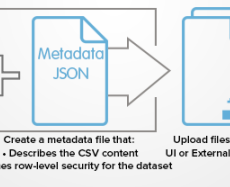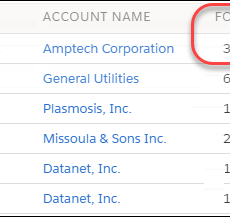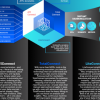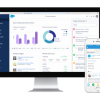When you think about digital transformation in the manufacturing segment, you think capacity planning, process modeling, robotics, workflow optimization, artificial intelligence for inventory management, and the like. All good aspects. But digital transformation can also play a key role in marketing within the manufacturing industry as well.
As a metal roofing & siding manufacturer, we relied mainly on pushing information about our products-primarily in the forms of collateral sheets and catalogs-to our channel partners and contractors in hopes of brand evangelism. A practice in place for many years. Over time however competition has increased dramatically, and we could no longer rely entirely on current channel arrangements. This may have worked in the past, but consumers and specifiers are looking for information via websites, videos, blogs, social platforms, and the like. They want to consume information 24 x 7 via desktop, mobile, and or tablets. These decision-makers want to be educated and inspired, and the demographics were shifting. They want two-way engagement-with immediate responses. They are savvy buyers doing the research before they make decisions. Our old methods were not going to work for future decision-makers. We had to build a marketing program for the next generation of customers based on digital channels, technologies, and engaging content. We were obligated to provide information and tools which convinced end users we were the product of choice wherever they were in the decision journey. It was important for us to drive brand awareness, and the value we bring to the industry, and ultimately create “pull-through”. To undertake this digital transformation, we needed to address several key elements.
Organizational Alignment
First and foremost, we needed executive team alignment on the need for change. Really not hard. A quick survey of the competition’s digital landscape quickly affirmed we needed upgrading. Our websites were outdated, there was limited to no social presence, no lead/demand generation, the content was spotty at best, and we had no means of measuring success. Second, as a marketing organization, we had to accept marketing had changed. We were entering a new era with marketing technology, tools, platforms, and data analytics driving the way. We had to understand our audiences were looking for information through multi-channel options. Lastly, we had to work across our organization, so they understood why we were making this transformation and how it benefited the company and our customers. In the end, we needed cultural alignment before we started. This is often the hardest part; convincing any organization for the need to change. But by getting executive sponsorship early on, accepting we needed to change as a marketing group, and working with key stakeholders across the business we were building the first step in transformation.
Strategy & Planning
Organizational alignment set, we needed a strategy and roadmap of what we were going to do, and how we were going to get there. Because we provided marketing to several business units, we needed to match not just technologies, but customers, products, content, channels to market as well as customer journeys. The strategy and roadmap provided tactical direction but allow us to plan 3-5 years into the future, which enabled us to program budget allocations and staffing accordingly. In addition, we aligned the plan with the overall company vision and strategy as well to the business level. By providing a top-down and bottom-up approach we were able to get cross-functional alignment within the organization on the vision.
Technology, Platforms, and Tools
First off was the websites. We have four business units to support, so each site had to be completely redone. We needed to ensure the content management system (in this case Word Press) was easy to use and something our internal team could maintain without too much external support. We developed the sites around specific personas and ensured we provided as much information as possible so users could find information with ease. We had to balance not just technical information but inspirational content such as idea books and color guides. We wanted to provide the right information as part of the first step in their journey. The below is an example of interactive product guide which we built on our website.

Once the sites were baselined, we added “calls-to-action” to drive lead generation and offer two-way engagement. We then expanded the sites by offering specific tools, such as product finder systems, project locators, interactive color charts, color, and 3D product visualizers, video product tours, blogs, where-to-buy via location as well as chatbots. All were designed to educate and inspire users and ensure they were locating relevant information quickly. The key to success was the continual review and optimization of each site and page. Here is an example of a screenshot of our project locator displaying results on google earth.
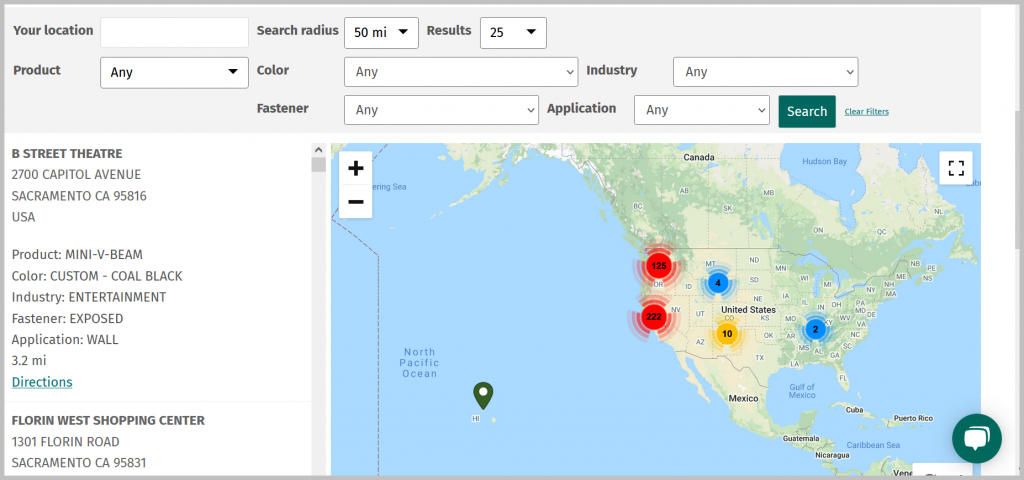
With almost no social presence we had to determine the best fit by business unit and platform. Facebook, LinkedIn, Instagram, YouTube, Houzz, Twitter, and Pinterest all offered different means to reach specific types of audiences. For example, LinkedIn as a professional network platform was good to reach hard to get audiences such as architects. Facebook and YouTube were optimal for consumer segments as well as general brand awareness. In the end, we leveraged multiple platforms to a certain extent depending on content, segmentation, and audience and desire (brand awareness vs lead generation). The ability to test each platform was important to understanding optimal performance, and investment.
Looking forward we needed a platform to tie content delivery, lead collection, and measure success. In the past, we relied on dispirit system and manual processes to accomplish these tasks. While there are several marketing automation systems available, we selected HubSpot as our system of choice. The critical aspect is to carefully review each type of system to ensure it meets organizational needs and future states.
Our ability to use data for decisions was paramount now that we had a basic digital platform in place. We needed to measure success and understand what was working and not working and adjust as needed. We had to prove the strategy, programs and budget were delivering results. Google Analytics was the foundation for all website activity. We also utilized such tools as MOZ and SEMRUSH to monitor and improve Search Engine Optimization and site health. Tools such as Hotjar allow us to create heatmaps for our site so we could understand a deeper level of engagement. The social channels provided solid analytic tools to measure campaign success and engagement rates.
HubSpot analytics enabled us to understand how specific campaigns were performing and serve as a central repository for leads, retargeting efforts, lead scoring, as well as lead nurturing. In addition, it allows detailed A/B testing of email efforts to allow maximin optimization.
Data analytics not only allowed us to gauge the effectiveness of websites and campaigns but also allowed us to understand what content resonated as well as identify potential process improvement options. We utilized data to prove our strategy. Successful use of data was not a “one and done” process but monthly activity conducted with rigor.
Content
At the cornerstone of any marketing program be it traditional or digital is content. The systems, platforms, data, and technologies are empty without content that adds value to your audience. They are mere mechanisms that transport the value your organization has to offer. It’s the content that drives users to engage. Often overlooked as part of the digital transformation, content is complicated and requires strategic planning. It must be unique and delivered at a consistent cadence. Our content strategy consists of four pillars:
• Educational: How to advise, recommendations, solve problems, the value of products and services.
• Inspirational: Colors, images, projects, design support
• Community: Volunteerism, community events, and support giving back
• People: People behind the products, stories about our employees, diversity & inclusion
We followed an 80/20 rule. 80% of the content was about trying to solve customer or industry problems, critical advice, and recommendations. 20% was focused just our own products
The content was developed depending on where the customer was in their decision journey. For example, idea books and color guides were centered on the discovery phase, while 3D installation guides and videos were focused more on the purchase actions. We used our marketing automation system as well as data analytics from websites and social channels to help identify which content was resonating and with what audiences. Equally important to the types of content was the frequency of delivery. We aimed for at least 2-3 pieces each week per business unit. Posting once a week or month will not suffice. Here is our sample virtual color palette to spur some creativity.
Staffing
Most organizations don’t have ready-made digital marketing teams-nor do they have funding for new hires or agency support. They tend to have traditional teams and skill sets in place. Ours was no different but we realized we had to evolve-and the team had solid understanding of marketing concepts. Having the strategy helped. The team understood direction and objectives as well as individual roles & responsibilities. There were no internal training programs available. So there had to be a good amount of direction and mentoring from experienced leaders to facilitate this transition to a new direction. In addition, we leveraged free courses and programs offered by our social channels, as well as technology tools such as HubSpot and Google. We encouraged staff to take these courses as part of their professional and personal development and tied back to their objectives. We also encouraged a good deal of information exchange between the team.
Takeaways
While digital transformation is an iterative process, there some critical components for success:
1. Organizational & Culture Alignment: Without this your digital transformation program will fail. You must have alignment and buy-in from the top down.
2. Strategy & Planning: You will need a solid strategy for success with clearly defined tactics and measurements, whereas everyone understands the intent and objectives-tying to company strategy and business drivers. Not just a one-year plan but out year planning as well.
3. Multi-Channel Delivery: The ability to leverage multiple, and correct platform(s) across different audience sets as well as conduct A/B testing is key.
4. Analytics: Need to understand how to leverage multiple data sources to help make decisions and recommend process improvement.
5. Content- Ability to deliver value add engaging content across different platform on a regular cadence throughout the customer journey.
6. Staffing: Be prepared to leverage free courses and even paid programs for your team if you don’t have the digital skill sets established. Key new hires are possible given budget conditions.
7. Patience: Digital transformation is a process and not an overnight success. Understanding results may take time.
Please subscribe
Subscribe to our mailing list and get tips to maximize salesforce to your email inbox.
I am honored to have your subscription. Stay tuned for tips to maximize your salesforce investment
Something went wrong.



